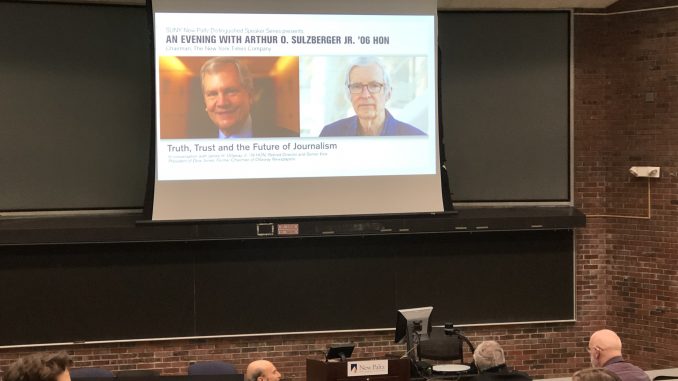
We live in an era of technology and communication. It seems that in an age where it is easier than ever to access information, we as a society should be the most informed we’ve ever been. Unfortunately, this is not the case.
Our society is in an epidemic of “fake news.” The displacement of newspapers by the uptick in social media has given way to jarring political misinformation within the last decade. Consequently, this has proven to take its toll on the nation, as seen in our current political climate.
To aide SUNY New Paltz in combating this issue, Chairman of The New York Times Arthur O. Sulzberger Jr., presented “Truth, Trust and the Future of Journalism,” in conversation with James H. Ottaway, on Wednesday, March 4, in Lecture Center 100.
Sulzberger served as publisher of The Times from 1992 to 2017, transforming it into an international, technology-forward news organization with five million paid subscribers and a global audience of over 130 million people. The Times won 61 Pulitzer Prizes under his leadership.
Facilitating the conversation was James H. Ottaway, the retired director and senior vice president of Dow Jones and former chairman of Ottaway Newspapers. A graduate of Yale University, Ottaway was recognized by SUNY New Paltz with an honorary doctorate of humane lectures in 2018.
The main call to action from “Truth, Trust and the Future of Journalism” was the support of journalism in an effort to rebuild a trusting relationship with the news.
“Free press is vital to society,” Sulzberger said. “Reporters make the factual world, providing us with a baseline of facts necessary to make important decisions [ranging from]war and peace to who you select for mayor.”
Sulzberger put a special emphasis on supporting small, local news organizations, regretting to inform the audience that “the crisis for journalism is worse for small newspapers that are dying very fast.”
For Amanda Gordon, a fourth-year journalism major, Sulzberger’s statements came as no surprise.
“I’m already pretty aware that the industry of journalism is changing in ways that don’t make my job prospects any easier,” Gordon said.
“It was, however, refreshing to hear someone associated with an international news market speak out on the decaying of small and local publications — which is also alarming given the fact that means less career outlets,” she continued.
Truth, trust and the future of journalism are all “under great and growing pressure.”
According to Sulzberger, 62% of Americans believe the news is biased and 44% believe the news is inaccurate.
Additionally, Sulzberger highlighted the importance of keeping up with the digital demands of the day.
In their conversation about how The Times continues to earn and keep the trust of its readers, Sulzberger explained to Ottaway that the company had to meet society where it was at — digitally.
As publisher, Sulzberger facilitated the “dramatic shift” that was the “[move] to digital production.” This transition to digital media production for The Times, a transition that many thought would lead to its demise, in fact led to “national and international growth [allowing The Times] to invest in journalism even more,” he explained.
Because society as a whole has become much more visually oriented in terms of the ingestion of media and news, Sulzburger highlighted how important it was for The Times to reduce the amount of copy editors, which allowed for an increase in editors in charge of visual graphics.
“One idea that the Chairman brought up that caught my attention was that the future of journalism is venturing into data driven news and with increased visualization,” Gordon said. “I still want to be a journalist, but I feel like I might have picked the wrong major, or at the very least, didn’t get the classes to give me a competitive edge in the field.”
Emma Misiaszek, a fourth-year journalism major, challenged Sulzberger on the notion of reducing copy editors, but he clarified that The Times does still have copy editors and the company values the position. However in the digital age, copy editing has become less important as reporters or editors can easily change errors in articles that have already been digitally published.
All in all, Sulzberger believes in “reporting the facts,” and sees this as the primary way to combat the age of fake news.
In response to Ottaway’s question on the importance of factual reporting, Sulzberger explained that the absence of facts is “a threat to our democracy, not The Times.”
Though the prime example of factual, real news, The Times is not perfect. Its imperfections, however, are another way that they build a trusting relationship with readers.
“Our job is to make sure we own our mistakes,” Sulzburger said.
The talk was a beacon of hope for a band of aspiring journalists from New Paltz High School, including Mark LaBorde, who hopes to one day work for an organization like The Times.
“This experience taught me a lot about what it’s really like in the world of journalism,” LaBorde said. “This made me more encouraged than ever to fight for truth and to maintain the trust of the people if I ever have the honor of being a journalist at a high end news organization.”
